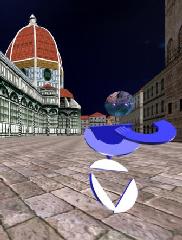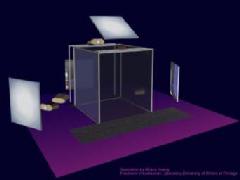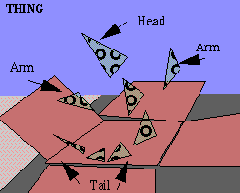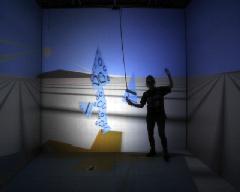Animation in the CAVE
By Josephine Anstey and
Dave Pape for
Animation World Magazine
http://www.awn.com/mag/index.phtml
Introduction
 You
walk into a ten by ten foot room, put on a special pair of glasses, and
take hold of a 3D mouse. As the program starts, the walls disappear. Now
you are surrounded by the cobbles, stonework and red tiles of an Italian
Renaissance city. Down the street you can see a cathedral. Pushing a button
on the mouse moves you forward. Then you see an anomaly - a sleek, electric
blue column. As you get closer, the column whirs and splits - a disjointed
little figure unfolds The figure gestures to you, then takes off. It looks
back and beckons, "Come on!"
You
walk into a ten by ten foot room, put on a special pair of glasses, and
take hold of a 3D mouse. As the program starts, the walls disappear. Now
you are surrounded by the cobbles, stonework and red tiles of an Italian
Renaissance city. Down the street you can see a cathedral. Pushing a button
on the mouse moves you forward. Then you see an anomaly - a sleek, electric
blue column. As you get closer, the column whirs and splits - a disjointed
little figure unfolds The figure gestures to you, then takes off. It looks
back and beckons, "Come on!"
You follow this strange guide to a dark stairway, winding up inside
the cathedral. At the top a low doorway takes you outside. The city stretches
beneath you - transparent pathways curl around the dome and lead back to
the ground. You see the little guide far below. He is dancing wildly as
a stream of flying letters and books sail past him and whip inside a building.
What is in there .....?
This is a description of an experience in the CAVE(TM) virtual reality
theatre. Virtual Reality is the art and science of using computers to create
three dimensional worlds that users can be immersed in, explore as they
please, and interact with in real time.
The CAVE (a recursive acronym for CAVE Automatic Virtual Environment)
is a virtual reality display device, but not the kind of head-mounted display
normally associated with VR. Instead, it's more like a prototype for Star
Trek's HoloDeck - a room that people can enter, with stereoscopic computer images
projected on the walls and floor. The computer continually updates and
redraws the display as users move through the environment.
One of the potentials of the CAVE is the creation of animated 3D worlds
and characters that a user can interact with: in effect making the user
part of a story.
History of the CAVE
The CAVE was created at the University of Illinois at Chicago's Electronic
Visualization Laboratory. EVL is a state of the art research lab for interactive
computer graphics, which brings together students from UIC's Schools of
Engineering and of Art and Design. It was founded in the early 1970s by
Dan Sandin, art professor and creator of the Sandin Image Processor, a
device well known in the video art community, and Tom DeFanti, engineering
professor and author of GRASS, an early computer animation system. The
Lab's work has always been a mixture of art, entertainment, engineering,
and science. In the 70s, EVL staged public performances of interactive
electronic art, and provided the computer hardware and software used to
create the original computer graphics in Star Wars. Later work included
developing graphics hardware that formed one of the first home computer
systems, investigating 3D fractal imagery, and
using visualization for scientific research with the National Center for
Supercomputing Applications.
In 1991, DeFanti and Sandin decided to use their experience with video
and interactive computer graphics to create a new approach to the growing
field of virtual reality. Traditional VR systems were head-mounted - a
pair of small video displays attached to a helmet or mechanical boom. Most
such displays were low-resolution, encumbering, and isolated the user.
EVL's new device - the CAVE - used video projection screens to create a
VR display that users entered, rather than wore. The CAVE display was
high-resolution,
only required the users to wear lightweight shutter glasses, and could
be shared by whole groups of people at once. It was implemented by EVL
students - Carolina Cruz-Neira, Greg Dawe, Sumit Das, and others
- and was first shown at the 1992 SIGGRAPH conference in Chicago. The full
system was completed barely in time for the conference, and many of the
applications demonstrated weren't seen in the CAVE itself until showtime.
 The CAVE is a 10 foot by 10 foot cube; three walls are rear projection screens,
and the floor is projected onto from above. High-end Silicon Graphics computers,
such as an Onyx2 Infinite Reality, generate the 3D images and simulate
the dynamics of the virtual world. Another SGI machine, connected to loudspeakers
in the four corners of the CAVE, creates the sounds of the environment.
The ImmersaDesk(TM) is a newer, smaller-scale version of the CAVE -
a drafting-table-style
display, rather than an entire room. Since 1992, over 50 CAVEs, ImmersaDesks,
and similar devices have been installed in universities, corporate labs,
and a few museums.
The CAVE is a 10 foot by 10 foot cube; three walls are rear projection screens,
and the floor is projected onto from above. High-end Silicon Graphics computers,
such as an Onyx2 Infinite Reality, generate the 3D images and simulate
the dynamics of the virtual world. Another SGI machine, connected to loudspeakers
in the four corners of the CAVE, creates the sounds of the environment.
The ImmersaDesk(TM) is a newer, smaller-scale version of the CAVE -
a drafting-table-style
display, rather than an entire room. Since 1992, over 50 CAVEs, ImmersaDesks,
and similar devices have been installed in universities, corporate labs,
and a few museums.
Applications
The difference between virtual reality and normal computer graphics is
that the user is immersed in the computer-generated environment. She is
surrounded by images and sound; the images are in stereoscopic 3D, rather
than flat on the screen; and the world is displayed in a first-person perspective,
from her viewpoint, rather than a third-person viewpoint common
to most other forms of image creation. To complete the immersion
in the virtual world, VR is interactive - the user can have (some) control
over what happens.
VR can be applied to any problem that can benefit from an immersive,
three-dimensional, interactive solution - whether in molecular
biology, cosmology, architecture and design, education, entertainment or
the arts. General Motors has started using CAVEs to evaluate
the design of new car interiors before having to build physical prototypes.
Old Dominion University is using an ImmersaDesk to view computer simulations
of the Chesapeake Bay ecosystem. At NCSA, Donna Cox used the CAVE program
Virtual Director to create animation for the IMAX film Cosmic Voyage. A
group at EVL has built a virtual island where children can tend a virtual
garden and learn about environmental concepts. EVL also participates fully
in the world of electronic art. Dan Sandin organised the opening show for
the first CAVE installed in a museum of Art and Technology, the Ars Electronica
Center in Linz, Austria, which featured projects by EVL faculty and students.
The Thing
We are currently working on a project, The Thing Growing, whose
focus is the construction of the "Thing," a virtual, interactive, animated
character in the CAVE. The goal of the project is to create a story in
which the user takes a leading role and is engaged at an emotional level
with the Thing.
 The Thing looks translucent. The triangular shapes forming its head, appendages
and body do not seem to join up. It changes colors as it speaks and according
to its moods. It is alternately bullying and loving. It has no specific
gender. Its goal is to make you dance with it, which it takes as a sign
of love and obedience.
The Thing looks translucent. The triangular shapes forming its head, appendages
and body do not seem to join up. It changes colors as it speaks and according
to its moods. It is alternately bullying and loving. It has no specific
gender. Its goal is to make you dance with it, which it takes as a sign
of love and obedience.
To animate in the CAVE we use tools familiar to any computer animator.
For example the models for The Thing Growing are being made in Softimage
and the textures are being made in Photoshop. These models are then imported
into the CAVE. In VR, the computer has to redraw the scene in about
one sixtieth of a second, in order to keep the frame rate at 30 frames per second
(remember it has to draw a different view for each eye). Therefore, even
with an Onxy2 these models must be far simpler than those of computer animation
for film and video, where you can spend minutes or hours rendering a single
frame. The gain, and
we think it's an exciting one, is being able to interact, in real time,
with a virtual character and world.
Virtual reality applications can use a wide variety of methods for
animating things: flipbooks, keyframing,
motion capture, and procedural (computer programmed) animation.
The Multi Mega Book in the CAVE (described at the beginning of this
article) uses a flipbook of 3D models to walk a wire-framed Judas out of Leonardo's
painting of the Last Supper.
In The Thing Growing rocks come alive and chase the user. When a
rock gets close enough it rears up and swallows her. In this case there
are only four simple models and the CAVE morphs between them to produce
the rock's growing and grabbing action.
We commonly use keyframe animation to move objects in a CAVE application.
For example to animate the flying letters referred to in the description
of the Multi Mega Book, keyframes were set to determine
the path of the letters through the city. As the letters move along this
path, a simple behavior routine makes them also spin and orbit each other.
The CAVE uses a tracking system to get information on the user's head
and hand position
in order for the computer to compute the perspective from a
user-centered point of view. Tracking is done with electromagnetic systems
such as the Ascension Flock of Birds; sensors are attached to the stereo glasses
and to the 3D mouse. We use this same system to record
motion tracked animation.
Our first experiments with this were for the Multi Mega Book.
Our collaborator, Franz Fischnaller, had already determined a shape for
the guide character - a simple collection of geometric shapes. We hooked
Franz up to four tracking sensors, one for the head, one for each arm,
and one for the body. At the same time we ran a CAVE program that took
the position and orientation information from the tracker and fed it to
the parts of the character's body which were then displayed. So as he moved
Franz could immediately see how the character would move. Its head moved
as he moved his head. Its arm waved as he moved his arm. In this way we
could build up animation for the individual body parts. Later, we could
define keyframes to move the body as a whole along a path through the virtual
world.
Although motion-tracking or keyframing are useful in creating movements
of characters and objects, they can't be used alone in VR. Because the
virtual world is interactive, the user is an integral part of it, and the
full progression of the storyline isn't known in advance. We can pre-animate
elements of the action - walk cycles, dances, gestures - but these elements
have to be combined dynamically in response to the user. Creating this
level of interaction is easily the most challenging aspect of CAVE animation.
Building interaction for the CAVE means making objects intelligent and
able to react to people. A simple example comes from The Thing Growing.
At one point in the narrative the Thing becomes so angry with the user
that it hides under one of the rocks in the vast plain the action takes
place on. This is the point when the other rocks come alive and start to
stalk and herd the user. Intelligence has to be programmed into the rocks
- they have to know where the user is, they have to avoid each other, and
they have to sneak up on the user and try to trap her. Instead of movement
based on keyframes, the rocks are given a set of rules on how to move until
one grabs the user. When that happens, all the other rocks scatter and
the user's ability to navigate is taken away. She is trapped with a rock
slobbering on her.
For the Thing itself we are using motion tracking to build up a library
of actions; in this case there are 8 body parts - head, two
arms, body, four tail sections. Each action lasts a few seconds and has
a corresponding sound bite. As the program runs, the Thing's intelligence
unit selects an appropriate action and sound according to the point in
the narrative, the user's actions, and the Thing's own emotional state.
The computer will interpolate between the end of one action
and the beginning of the next, so that the movement is smooth.
The Thing's intelligence also decides how the body as a whole
moves. This movement may be relative to the user, as the Thing stays close
or swoops in on the user. Or it may decide to move to a particular spot
in the environment. All the while it has to avoid other objects. The computations
for these movements are done on the fly using a set of rules and information
about the position of the user, the Thing, and other objects.
The Thing has four basic moods: happy, depressed, manic, angry. Its
emotional state is established in part from information about the user.
Essentially all that the computer, and therefore the Thing, can know about
a user is the tracked position and orientation of the user's head and one,
or both, hands. So, for example, we keep track of the
user's head position relative to the Thing - if the user looks at the Thing
most of the time, it interprets that as attentiveness and that makes
it happy. We also monitor the general activity of the user. A user that
moves about a lot is fast, and this will tend to make a happy Thing manic.
If the Thing is not so happy, fast user movement will make it angry, slow
user movement will make it depressed. The Thing's emotional state will
also fluctuate according to an internal set of rules, so that the emotions
are not simply a reflection of the user - too much of any one emotion will
flip it over into a different one.
 In addition to monitoring the user in general, we check specific user movements.
The Thing is attempting to teach the user a dance. It will demonstrate
each part of the dance, then observe or join the user as she copies the
movement. Each of the parts of the dance will be one of the Thing's actions.
And each of these particular actions will have a test associated with it
to verify whether the user is dancing correctly. Knowing whether the user
is dancing correctly will feed back both to the Thing's emotional component
and to its decision-making process. It may decide to repeat a part of the
dance that the user is doing incorrectly. It will admonish, encourage or
praise the user according to the user's behavior and its own mood.
In addition to monitoring the user in general, we check specific user movements.
The Thing is attempting to teach the user a dance. It will demonstrate
each part of the dance, then observe or join the user as she copies the
movement. Each of the parts of the dance will be one of the Thing's actions.
And each of these particular actions will have a test associated with it
to verify whether the user is dancing correctly. Knowing whether the user
is dancing correctly will feed back both to the Thing's emotional component
and to its decision-making process. It may decide to repeat a part of the
dance that the user is doing incorrectly. It will admonish, encourage or
praise the user according to the user's behavior and its own mood.
Conclusion
This process of developing an animated character focuses on maximizing
the advantages of CAVE VR - immersion in an interactive 3D world - and
minimizing the disadvantages - the relative simplicity of images. It was
immediately obvious that any degree of photo-realism, and even the visual
complexity of most computer animation, was impossible. This resulted in
a decision to make a very clean, uncomplicated environment, and to create
a virtual character who is simply a collection of pyramids. Capturing the
motion for the Thing's head and limbs is the most efficient and effective
way of giving this collection a life.
Thereafter, the most daunting task is to give that life intelligence.
The starting point is assessing its sensory inputs - the tracking information.
In building the
intelligence component we interpret the data the Thing receives, but we
also try to construct its character so that the paucity of the information
it is working with is not apparent. The Thing is high-handed and willful
- in part because of the exigencies of the story line and in part to hide
its stupidity. It is inconsistent, arbitrarily praising or abusing the user
for the same behavior - in part to mimic the inconsistency of many people,
in part to hide its ignorance.
The Thing Growing is still under development. At this stage we can't
judge how effective or real an experience it will give a user. But we hope
that after testing and refining the program, it will be possible for the
Thing to build a relationship with a user - however virtual that relationship
may be.
 The CAVE is a 10 foot by 10 foot cube; three walls are rear projection screens,
and the floor is projected onto from above. High-end Silicon Graphics computers,
such as an Onyx2 Infinite Reality, generate the 3D images and simulate
the dynamics of the virtual world. Another SGI machine, connected to loudspeakers
in the four corners of the CAVE, creates the sounds of the environment.
The ImmersaDesk(TM) is a newer, smaller-scale version of the CAVE -
a drafting-table-style
display, rather than an entire room. Since 1992, over 50 CAVEs, ImmersaDesks,
and similar devices have been installed in universities, corporate labs,
and a few museums.
The CAVE is a 10 foot by 10 foot cube; three walls are rear projection screens,
and the floor is projected onto from above. High-end Silicon Graphics computers,
such as an Onyx2 Infinite Reality, generate the 3D images and simulate
the dynamics of the virtual world. Another SGI machine, connected to loudspeakers
in the four corners of the CAVE, creates the sounds of the environment.
The ImmersaDesk(TM) is a newer, smaller-scale version of the CAVE -
a drafting-table-style
display, rather than an entire room. Since 1992, over 50 CAVEs, ImmersaDesks,
and similar devices have been installed in universities, corporate labs,
and a few museums.
 You
walk into a ten by ten foot room, put on a special pair of glasses, and
take hold of a 3D mouse. As the program starts, the walls disappear. Now
you are surrounded by the cobbles, stonework and red tiles of an Italian
Renaissance city. Down the street you can see a cathedral. Pushing a button
on the mouse moves you forward. Then you see an anomaly - a sleek, electric
blue column. As you get closer, the column whirs and splits - a disjointed
little figure unfolds The figure gestures to you, then takes off. It looks
back and beckons, "Come on!"
You
walk into a ten by ten foot room, put on a special pair of glasses, and
take hold of a 3D mouse. As the program starts, the walls disappear. Now
you are surrounded by the cobbles, stonework and red tiles of an Italian
Renaissance city. Down the street you can see a cathedral. Pushing a button
on the mouse moves you forward. Then you see an anomaly - a sleek, electric
blue column. As you get closer, the column whirs and splits - a disjointed
little figure unfolds The figure gestures to you, then takes off. It looks
back and beckons, "Come on!"
 The Thing looks translucent. The triangular shapes forming its head, appendages
and body do not seem to join up. It changes colors as it speaks and according
to its moods. It is alternately bullying and loving. It has no specific
gender. Its goal is to make you dance with it, which it takes as a sign
of love and obedience.
The Thing looks translucent. The triangular shapes forming its head, appendages
and body do not seem to join up. It changes colors as it speaks and according
to its moods. It is alternately bullying and loving. It has no specific
gender. Its goal is to make you dance with it, which it takes as a sign
of love and obedience.
 In addition to monitoring the user in general, we check specific user movements.
The Thing is attempting to teach the user a dance. It will demonstrate
each part of the dance, then observe or join the user as she copies the
movement. Each of the parts of the dance will be one of the Thing's actions.
And each of these particular actions will have a test associated with it
to verify whether the user is dancing correctly. Knowing whether the user
is dancing correctly will feed back both to the Thing's emotional component
and to its decision-making process. It may decide to repeat a part of the
dance that the user is doing incorrectly. It will admonish, encourage or
praise the user according to the user's behavior and its own mood.
In addition to monitoring the user in general, we check specific user movements.
The Thing is attempting to teach the user a dance. It will demonstrate
each part of the dance, then observe or join the user as she copies the
movement. Each of the parts of the dance will be one of the Thing's actions.
And each of these particular actions will have a test associated with it
to verify whether the user is dancing correctly. Knowing whether the user
is dancing correctly will feed back both to the Thing's emotional component
and to its decision-making process. It may decide to repeat a part of the
dance that the user is doing incorrectly. It will admonish, encourage or
praise the user according to the user's behavior and its own mood.